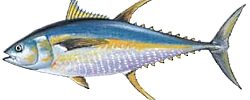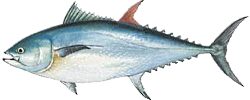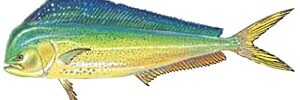Offshore Pelagics

OFFSHORE PELAGICS: TUNAS, DOLPHIN AND WAHOO
Occurring in all tropical, subtropical and temperate oceans of the world, tunas, dolphin and wahoo are one of the fastest swimming groups of fish in the sea and one of the most highly prized by both recreational and commercial fishermen for their excellent food quality.
The swimming and fighting strength of these fish, when taken by rod and reel, has resulted in their being considered top game species by recreational fishermen, second only to the bigger and more acrobatic billfishes (blue and white marlin and sailfish). Tunas, dolphin and wahoo occur throughout the year in warm, cobaltblue water of the Gulf Stream 35 to 75 miles off South Carolina’s coast. During the early spring and summer these fish follow warm ocean currents into shallow water 20 to 25 miles offshore.
Pelagic fishes swim and feed in the upper portion of the water column. Tunas, dolphin and wahoo feed near the top of the pelagic food chain, preying on smaller fish, squid, crustaceans and other invertebrates often associated with sargassum seaweed. Built for speed, these fish travel great distances often in schools according to size. Schooling probably protects small fish from predators. Larger tuna, dolphin and wahoo generally lead a more solitary existence. How these open water species navigate within the vast pelagic environment of the world’s ocean remains a mystery.
Most pelagic fish tend to aggregate near floating objects such as logs, buoys or debris. Whereas tuna are generally an open water species, dolphin and wahoo frequent sargassum,a surfacefloating algae which drifts in patches and occurs in large rafts offshore along the warm waters of the Gulf Stream.
Tuna and other highly migratory pelagic species (swordfish, sharks, dolphin) are taken commercially by a variety of fishing gears including purse seines, longlines, drift gill nets, rods and reels, hand lines and harpoons. In 1996, 28,900 metric tons of tuna were landed by United States Fishermen.
The commercial harvest of these fish off South Carolina and throughout the Atlantic is primarily by pelagic longline vessels. These vessels fish a line up to 40 miles long with thousands of baited hooks. Historically, tuna have been the primary target of these vessels which take hundreds of metric tons annually and in recent years have overfished bluefin.
In 1969, 24 countries which fish in the Atlantic Ocean, including the United States, established the International Commission for the Conservation of Atlantic Tunas (ICCAT) which is charged with managing all Atlantic highly migratory species, including bluefin tuna. Unfortunately, bluefin tuna populations and several other highly migratory pelagic stocks have continued to decline in the western Atlantic, despited the actions of ICCAT.
TUNAS
 Ten tuna species inhabit Atlantic waters off South Carolina: five little tunas (little tunny, Euthynnus alletteratus; skipjack tuna, Katsuwonus pelamis; Atlantic bonito, Sarda sarda; frigate mackerel, Auxis thazard; bullet mackerel, Auxiz rochchei) and five tunas (albacore, Thunnus alalunga; blackfin, Thunnus atlanticus; bluefin, Thunnus thynnus; bigeye, Thunnus obesus; and yellowfin, Thunnus albacares). Although there is a tremendous variation in adult size, all have a football-shaped body and a rigid, powerful tail, both important in increasing swimming efficiency.
Ten tuna species inhabit Atlantic waters off South Carolina: five little tunas (little tunny, Euthynnus alletteratus; skipjack tuna, Katsuwonus pelamis; Atlantic bonito, Sarda sarda; frigate mackerel, Auxis thazard; bullet mackerel, Auxiz rochchei) and five tunas (albacore, Thunnus alalunga; blackfin, Thunnus atlanticus; bluefin, Thunnus thynnus; bigeye, Thunnus obesus; and yellowfin, Thunnus albacares). Although there is a tremendous variation in adult size, all have a football-shaped body and a rigid, powerful tail, both important in increasing swimming efficiency.
 Adult little tunas range from the 2- pound bullet mackerel to the 40- pound skipjack tuna. Mature tunas begin at 20 pounds (blackfin tuna) with the bluefin being the heavyweight of the group reaching nearly 1,500 pounds.
Adult little tunas range from the 2- pound bullet mackerel to the 40- pound skipjack tuna. Mature tunas begin at 20 pounds (blackfin tuna) with the bluefin being the heavyweight of the group reaching nearly 1,500 pounds.
 Despite the wide variation in adult sizes, all tunas begin life at the same size and in much the same manner. Tunas disperse their buoyant eggs, which are about one millimeter in size, into the open sea. A single bluefin tuna may produce in excess of 25 million eggs per spawn. After drifting in warm ocean currents for up to three days, young tuna eggs hatch.
Despite the wide variation in adult sizes, all tunas begin life at the same size and in much the same manner. Tunas disperse their buoyant eggs, which are about one millimeter in size, into the open sea. A single bluefin tuna may produce in excess of 25 million eggs per spawn. After drifting in warm ocean currents for up to three days, young tuna eggs hatch.
 Beginning with food within the yoke sac, tuna gradually change their diet from the smallest members of the planktonic community, to larval crustaceans and fish, to small fish such as anchovies, sardines, herrings and squid. As tuna become larger, they seek larger and larger prey. Feeding constantly, tunas grow quickly. Yellowfin tuna may reach more that 140 pounds in four years and bluefin, which may live 20 years, generally weigh more than 700 pounds by their 14th year.
Beginning with food within the yoke sac, tuna gradually change their diet from the smallest members of the planktonic community, to larval crustaceans and fish, to small fish such as anchovies, sardines, herrings and squid. As tuna become larger, they seek larger and larger prey. Feeding constantly, tunas grow quickly. Yellowfin tuna may reach more that 140 pounds in four years and bluefin, which may live 20 years, generally weigh more than 700 pounds by their 14th year.DOLPHIN
Dolphin occur in all tropical and subtropical oceans of the world. Whereas the smaller pompano dolphin is primarily an oceanic fish, the common dolphin frequently enters coastal waters. The range of the common dolphin, Coryphaena hippurus, in the western Atlantic is from George’s Bank, Nova Scotia, to Rio de Janeiro, Argentina. Dolphin are prevalent in the Gulf of Mexico and throughout the Caribbean Sea.
 Dolphin occur in all tropical and subtropical oceans of the world. Whereas the smaller pompano dolphin is primarily an oceanic fish, the common dolphin frequently enters coastal waters. The range of the common dolphin, Coryphaena hippurus, in the western Atlantic is from George’s Bank, Nova Scotia, to Rio de Janeiro, Argentina. Dolphin are prevalent in the Gulf of Mexico and throughout the Caribbean Sea.
Dolphin occur in all tropical and subtropical oceans of the world. Whereas the smaller pompano dolphin is primarily an oceanic fish, the common dolphin frequently enters coastal waters. The range of the common dolphin, Coryphaena hippurus, in the western Atlantic is from George’s Bank, Nova Scotia, to Rio de Janeiro, Argentina. Dolphin are prevalent in the Gulf of Mexico and throughout the Caribbean Sea.
Not only one of the fastest swimming and best tasting fish in the sea, the common dolphin is one of the most beautiful. The living fish displays a bright, iridescent blue and green upper body and the lower body usually shines brilliant yellow with bright blue and green spots, streaks and flecks. The magnificent color of a living fish, which has a lighted or glowing appearance, quickly fades with death to a rather uniform, unimpressive dark silvery-yellow color.
Dolphin males and females are easily distinguished. Males, the larger of which are called bull dolphin, have a pronounced vertical forehead giving the head a very boxlike appearance. Female dolphin have a more sloping, typical fish-like head and are referred to as cows. The name “dolphin” confuses these fish with the mammal commonly called a dolphin or a porpoise. On most restaurant menus, dolphin is better known by its Hawaiian name, “mahimahi.” Dolphin are cannibalistic and voracious, feeding primarily on fish, crustaceans and squid. Growth is extremely rapid, with one-year old fish averaging 13 pounds, two-year old 27 pounds, three-year old 55 pounds, and four-year old reaching 75 pounds.
Aquarium-raised fish have shown incredible growth rates. Two dolphin weighing approximately 1 ½ pounds were placed in a Florida aquarium and reportedly grew to 32 and 37 pounds in seven months. Another one-pound dolphin, reared in a Miami sea aquarium, grew to 36 pounds in eight months.
Dolphin not only have a wide range of prey, but also have numerous predators. Dolphin have been taken from the stomachs of swordfish, sailfish, blue and white marlin, yellowfin tuna, albacore tuna and larger dolphin. Dolphin reach sexual maturity as small as 14 inches in length and spawning may occur year-round. Dolphin spawned in one season may grow, reach sexual maturity and spawn in that season, a period of just a few months.
Little is currently known about the condition of Atlantic dolphin stocks. In Japan, China and other areas of the Pacific, “mahi-mahi” has historically been an important food fish. Commercial harvest of dolphin in the Atlantic, particularly off the continental United States is relatively small but has increased during the past few years. Most dolphin taken recreationally off the South Carolina coast are either caught by anglers specifically targeting small school dolphin, or taken incidentally by offshore anglers trolling for blue marlin and other billfish. These latter fish are generally larger, more solitary dolphin.
WAHOO
The wahoo, Acanthocybium solandri, with an elongated cylindrical-shaped body built for speed, is one of the fastest fish in the sea. Unlike the dolphin’s brilliant blues, greens and yellows, with every fish portraying individual markings, the wahoo is uniformly colored with dark iridescent blue vertical bands on its sides, over a body coloration grading from steel or metallic blue dorsally into a silvery underside. Wahoo have a distinctively long snout, with large, razor-sharp teeth.
 Wahoo occur year-round in the Gulf Stream waters off the southeast coast of the United States. This species does not travel or gather in large schools, but is abundant off the Carolinas during spring and summer, although never as abundant as tuna or dolphin. Wahoo are primarily caught by recreational fishermen and as by-catch by commercial tuna and dolphin vessels.
Wahoo occur year-round in the Gulf Stream waters off the southeast coast of the United States. This species does not travel or gather in large schools, but is abundant off the Carolinas during spring and summer, although never as abundant as tuna or dolphin. Wahoo are primarily caught by recreational fishermen and as by-catch by commercial tuna and dolphin vessels.
The wahoo’s rapid growth rate, great speed and large teeth all are indicative of a top level predator. Wahoo consume smaller bullet and frigate tuna, king and Spanish mackerels as well as jacks, butterfish, flying fish and herrings. After their first year of life, wahoo average about 3½ feet and weigh around 15 pounds. Two-year old fish average about 35 pounds. Most wahoo taken off the Carolinas are less than four years old, but occasionally older and larger fish are taken.
CONSERVATION
Dolphin, wahoo and most tunas, especially yellowfin, are delicious grilled, boiled or baked. In the past, offshore fishermen trolling for billfish often caught these fish in abundance whenever available.
The establishment of the Blue Water Conservation Award within the Governor’s Cup Billfishing Series however, has encouraged the tag and release of these species. Boats fishing in the Series can accumulate points for the tag and the release of dolphin, wahoo and yellowfin and qualify for a separate trophy. This incentive has inspired many anglers, whether fishing in tournaments or not, to keep just a few of these “meat fish” per trip, while releasing most of their catch.
Increasing fishing capacity of domestic and international vessels, coupled with the ever increasing demand for marine fish for food and angling pleasure, long ago dispelled the concept that our oceans’ resources are limitless and can provide an endless bounty of seafood. The increasing number and size of ocean-going fishing vessels and the development of sophisticated electronic devices to locate and track marine fish throughout all the world’s oceans has clearly demonstrated that we now have the capacity and ability to overfish and deplete the ocean’s natural resources.
Bluefin tuna in the 1960’s accounted for as much as 80 percent of the domestic tuna landings in the western Atlantic. Today this species accounts for less than 10 percent. Bluefin tuna breeding populations declined 90 percent between 1975 and 1992. Other highly prized marine fish, such as swordfish, blue and white marlin, several species of sharks and many other marine fish also are currently being overfished.
The realization that ocean fishery resources are finite and their capacity to be harvested has been reached or exceeded, has and will result in increasing conflicts both between nations and various domestic user groups. Recent actions by International Commission for the Conservation of Atlantic Tunas to strengthen its ability to penalize countries which do not comply with fishery management measures should help with conserving these fisheries stocks in the future. However, all nations and all fishermen, both commercial and recreational must do their part to conserve and protect these resources for future generations. It is difficult for recreational fishermen who individually harvest a limited number of fish to appreciate the total impact of tens or hundreds of thousands of recreational anglers, each taking just a few fish. It is far easier to see and understand the impact of a commercial fishing vessel coming to port with several days’ or weeks’ catch, all being off-loaded at one time.
In order to sustain marine fisheries for future generations, effective management depends on all user groups working together to develop a fishing ethic which promotes wise use and conservation practices that will both provide fish for the market place today and insure healthy populations of fish in the future.
SALTWATER FISHING CONSERVATION & ETHICS
Although most people once considered ocean resources to be unlimited, recent rapid declines in the populations of many commercial and recreational species have demonstrated the opposite.
Numerous types of saltwater game fish now are being over harvested and other species will face a similar fate unless all anglers practice wise conservation and adopt an ethical approach to fishing.
Size and catch limits, seasons and gear restrictions should be adhered to strictly. These regulations change from time to time as managers learn more about fish life histories and how to provide angling opportunities without depleting stocks.
The challenge of catching, not killing fish, provides anglers with the excitement and the reward of fishing. Undersized fish, or fish over the limit should be released to ensure the future of fish populations. The number of saltwater finfish tagged and released annually in South Carolina has increased significantly in recent years as more and more fishermen take up this practice that provides information on growth and movement of fish as well as conserving resources.
Saltwater fishermen can further contribute to conservation by purchasing a Marine Recreational Fisheries Stamp which is required to fish from a private boat or gather shellfish in South Carolina’s saltwaters. Funds generated by the sale of stamps must be spent on programs that directly benefit saltwater fish, shellfish and fishermen.
SPECIAL NOTE
This publication was made possible in part with funds from the sale of the South Carolina Marine Recreational Fisheries Stamp. Help ensure outdoor enjoyment for future generations by strictly adhering to all rules, regulations, seasons, catch limits and size limits. The South Carolina Department of Natural Resources publishes an annual Rules and Regulations booklet that lists all saltwater fishing regulations. Have an enjoyable fishing trip by reading these requirements before you fish.
